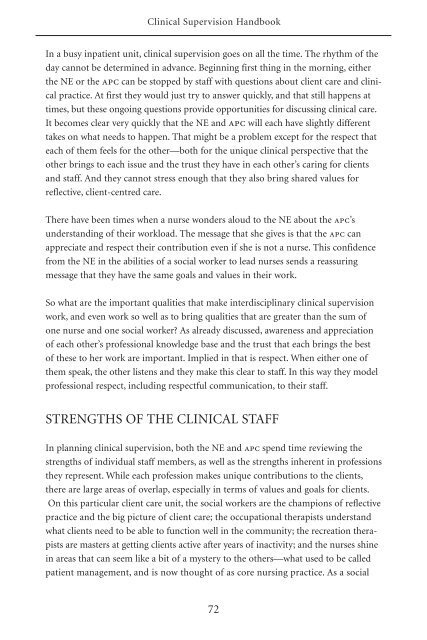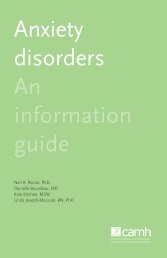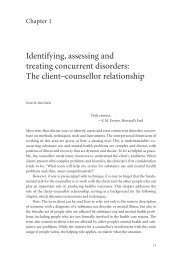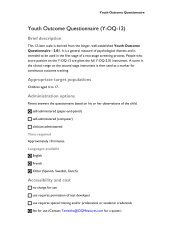Clinical Supervision Handbook - CAMH Knowledge Exchange ...
Clinical Supervision Handbook - CAMH Knowledge Exchange ...
Clinical Supervision Handbook - CAMH Knowledge Exchange ...
You also want an ePaper? Increase the reach of your titles
YUMPU automatically turns print PDFs into web optimized ePapers that Google loves.
<strong>Clinical</strong> <strong>Supervision</strong> <strong>Handbook</strong><br />
In a busy inpatient unit, clinical supervision goes on all the time. The rhythm of the<br />
day cannot be determined in advance. Beginning first thing in the morning, either<br />
the NE or the apc can be stopped by staff with questions about client care and clinical<br />
practice. At first they would just try to answer quickly, and that still happens at<br />
times, but these ongoing questions provide opportunities for discussing clinical care.<br />
It becomes clear very quickly that the NE and apc will each have slightly different<br />
takes on what needs to happen. That might be a problem except for the respect that<br />
each of them feels for the other—both for the unique clinical perspective that the<br />
other brings to each issue and the trust they have in each other’s caring for clients<br />
and staff. And they cannot stress enough that they also bring shared values for<br />
reflective, client-centred care.<br />
There have been times when a nurse wonders aloud to the NE about the apc’s<br />
understanding of their workload. The message that she gives is that the apc can<br />
appreciate and respect their contribution even if she is not a nurse. This confidence<br />
from the NE in the abilities of a social worker to lead nurses sends a reassuring<br />
message that they have the same goals and values in their work.<br />
So what are the important qualities that make interdisciplinary clinical supervision<br />
work, and even work so well as to bring qualities that are greater than the sum of<br />
one nurse and one social worker? As already discussed, awareness and appreciation<br />
of each other’s professional knowledge base and the trust that each brings the best<br />
of these to her work are important. Implied in that is respect. When either one of<br />
them speak, the other listens and they make this clear to staff. In this way they model<br />
professional respect, including respectful communication, to their staff.<br />
STRENGTHS OF THE CLINICAL STAFF<br />
In planning clinical supervision, both the NE and apc spend time reviewing the<br />
strengths of individual staff members, as well as the strengths inherent in professions<br />
they represent. While each profession makes unique contributions to the clients,<br />
there are large areas of overlap, especially in terms of values and goals for clients.<br />
On this particular client care unit, the social workers are the champions of reflective<br />
practice and the big picture of client care; the occupational therapists understand<br />
what clients need to be able to function well in the community; the recreation therapists<br />
are masters at getting clients active after years of inactivity; and the nurses shine<br />
in areas that can seem like a bit of a mystery to the others—what used to be called<br />
patient management, and is now thought of as core nursing practice. As a social<br />
72

















